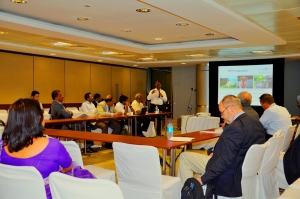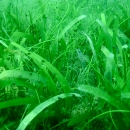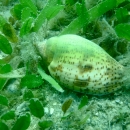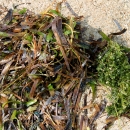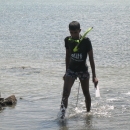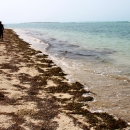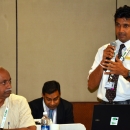Newsroom :: News :: MFF at the CBD COP 11. Focus on need for collaborative efforts to conserve sea grass beds in the Gulf of Mannar.
MFF at the CBD COP 11. Focus on need for collaborative efforts to conserve sea grass beds in the Gulf of Mannar.
Location: Hyderabad, India. 22nd Oct 2012
Opening the session, National Coordinator for MFF India Dr. NM Ishwar gave an overview of the MFF vision, regional activities, and briefed the session on the MFF grants modalities.
Speaking at the event, key speakers Dr. Terney Pradeep Kumara, Faculty of Fisheries and Marine Sciences & Technology, University of Ruhuna Sri Lanka and Dr. J K Patterson Edward from Suganthi Devdason Marine Research Institute (SDMRI) India, presented the key findings of their MFF supported joint study. Their study has brought to surface crucial information regarding the species composition and diversity, abundance, distribution patterns and threats to the survival of sea grasses in the Gulf of Mannar.
On the Sri Lankan side, the completed study in Puttalam lagoon and ongoing study covering the coastal stretch from Kalpitiya to Thaleimannar has revealed eight species of seagrasses belonging to six genera of which three are common. On the Indian side, the study revealed that seagrass beds distributed over an area of 101 sq. km between Rameshwaram and Tuticorin has indicated the occurrence of 35% sea grass cover along 140 Km long coastal area. There are 21 uninhabited islands surrounded by coral reefs and dense seagrass beds are seen between the islands and mainland shore.
In stark disparity to their important ecosystem support services which include maintaining water clarity and nursery areas for juvenile fishes and aquatic fauna, seagrasses are under considerable threat due to human activities such as over fishing, and mechanical destruction of habitat. Increasing human activities like trawling and boat traffic contribute to scouring and scraping of the sea beds which uproot the seagrasses. Other threats include industrial and domestic effluents, oil and gas exploration and dynamite fishing which is on the rise on the Sri Lankan side of the Gulf. Among other threats, the cultivation of exotic seaweed species Kappaphycus alvarezii also looms large.
The session acknowledged the need to develop a long term framework strategy to help restore seagrass ecosystems in degraded areas and recommended up scaling of collaborative research, capacity development and effective ways of communicating seagrasses as being vital elements for marine ecosystem health and sustainability of fishing industries.
Through MFF and its partners, such as the Bay of Bengal Large Marine Ecosystem Project of the FAO, there is a partnership in place to address the identified issues or required collaborative activities.
